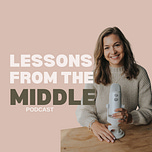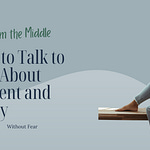🎧 listen to the full episode here
Let’s talk about something I’ve been thinking about a lot lately—kids’ activities and how to avoid the chaos spiral that seems to come with every new sports season.
I saw a post the other day reminding parents not to overschedule their kids. And honestly, yes. I 1000% agree. But, like most things in parenting, I find myself landing somewhere in the middle. (Fitting, right? Given the name of this podcast.)
So today, I want to share how we’re navigating activities in our family—three little kids who want to do all the things—while still prioritizing connection, rest, and fun. Because wow, spring sports season is a lot.
My Childhood Experience Shaped How I Parent
Growing up, I didn’t do many activities. The ones I did were only possible if they happened right after school—my dad worked far away, and I was almost always the last kid to get picked up. Even when I did play sports in high school, no one really came to watch.
I remember that clearly—looking around and seeing friends with a cheering section, while I felt invisible. And I know I’m not alone in that. So, like a lot of parents, I swung the pendulum. I wanted my kids to have the opposite experience.
But here’s the thing: when we swing too far, we often miss the middle. That’s where I try to land, always—especially in parenting.
Why Are We Saying Yes?
Here’s a question I’ve been asking myself: Why are we saying yes to certain activities?
Is it because my kids are genuinely curious? Do they want to explore something new? Or am I saying yes because I feel like they should be involved, or because other families are doing it, or because I’m chasing some imaginary “ideal childhood” checklist?
For me, a lot of it goes back to anxiety. As a kid, I had a lot of it—especially after my parents divorced—and I never really got the chance to prove to myself that I could try new things and be okay. That held me back. Still does, sometimes.
So when I say yes to activities, it’s about helping my kids build confidence. Helping them stretch themselves, see what they’re into, and have fun. Fun is the goal. Not performance. Not perfection. Just experience, connection, and joy.
When Sports Stop Being Fun
Let’s talk about pressure for a second.
My six-year-old plays soccer. At six. And yet, even in these little kid leagues, there’s pressure. Not just to participate, but to perform.
I’ve overheard conversations where parents talk about how they’re already worried their kid is “behind” in sports… at six years old. One parent told me they felt like they signed their daughter up for lacrosse too late. She’s in first grade.
What are we doing?
If our kids are out there trying new things, laughing with teammates, moving their bodies, and discovering what they enjoy—that should be the win.
One of my favorite parenting moments recently was watching my daughter score her first goal. Yes, we celebrated the goal. But more than that, I celebrated her effort—her confidence, her willingness to get in the game, her joy. That mattered even more.
What Rest Actually Means
Now, yes, I absolutely believe our kids need rest. But we have to talk about what rest really looks like.
If “rest” means zoning out in front of an iPad for hours, I’d argue that’s not rest at all—it’s just overstimulation in a different form.
In our house, we have firm boundaries around tech. No devices during the week. We save shows for Friday movie nights or a little weekend screen time. So when my kids aren’t at activities, they’re playing outside, helping with dinner, building forts, wresting with each other 🫠. That’s the kind of rest we’re after—the unstructured, out-in-nature-when-possible kind.
Rest doesn’t have to mean silence or sleep. It can look like a neighborhood walk, digging in the mud, or playing a game of Uno. The goal is balance. And connection.
The Bigger Picture
As a middle school counselor, I’ve seen the full spectrum—kids who are overscheduled and burned out, kids thriving with lots of activities, and kids with nothing on the calendar who feel disconnected and struggle to find belonging.
There’s no one-size-fits-all. But I do know that when kids have at least one “thing” that’s theirs—something they enjoy, a team they belong to, a coach who cheers them on—it can be powerful. It builds identity, confidence, and connection outside of school and home.
And honestly, some of my most impactful mentors weren’t even teachers—they were coaches, neighbors, cheer moms. Adults who saw me. Who showed up. I want that for my kids too.
So Where Do We Land?
Here’s what I’m learning as we navigate the activity-filled seasons of parenting:
Say yes with intention.
Celebrate the effort, not just the outcome.
Prioritize joy and connection over perfection.
Protect downtime
And always, always ask: is this working for our family?
There is so much noise out there. So many expectations. But you get to decide what rhythm works for your crew.
You don’t have to choose between all the things or nothing at all. You can find your own version of the middle.
That’s where the magic is.
🎧 Want to hear more on this topic? Listen to the full podcast episode right here. I’m diving deeper into how we’re navigating spring activities, what rest really looks like for kids, and how to find that middle ground between overscheduling and under-involving.












Share this post